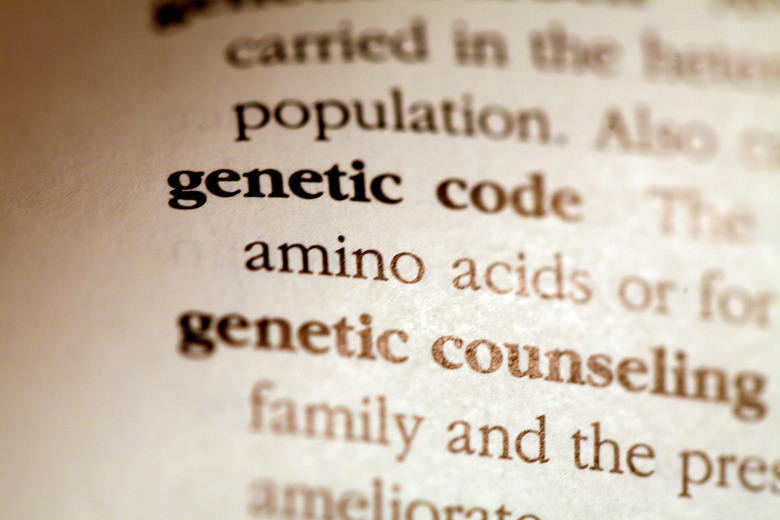How To Isolate MRNA From A Cell
A cell's genetic blueprint is encoded within its genetic material, or DNA. As the DNA never leaves the nucleus of the cell, in order for this information to get into the cytoplasm where other proteins and biochemical components reside, it is necessary to first transcribe the DNA into messenger RNA (mRNA or poly(A) RNA). This mRNA then becomes translated into proteins that carry out many functions of the cell. To detect or quantify very rare mRNAs, make probes for microarrays or construct libraries of complementary DNA molecules, mRNA must be isolated. However, total RNA (i.e. all the RNA in a cell) extraction and subsequent mRNA isolation are not mutually exclusive processes; the former must be performed in order for mRNA to be extracted.
Isolation of mRNA From Total RNA
Step 1
TRIzol homogenization: Total RNA includes all mRNA , transfer RNA, ribosomal RNA, and other noncoding RNAs. To separate these from other cellular components, the cell is first burst open to release its contents. This is done by resuspending cells pelleted by centrifuging (spinning at high speeds) in TRIzol Reagent (Life Technologies). Other versions of TRIzol (such as Ambion's TRI Reagent) work similarly.
Step 2
Total RNA Isolation: A series of centrifugations is used to separate the different components (proteins, DNA, RNA) of the cell into layers, or phases, within the suspension. The top, yellow-colored phase is composed of fat and can be discarded. The desired phase is tinted red, contains the total RNA and is retained. After performing a phenol-chloroform extraction and a series of alcohol washes using isopropanol and ethanol, the RNA can be pelleted for mRNA isolation. Add RNase inhibitors to prevent this enzyme from degrading the total RNA.
Step 3
mRNA Extraction: It is common to use a kit to isolate mRNAs, as homemade lab protocols do not generate large quantities of highly purified mRNAs. Commercial kits include Invitrogen's FastTrack 2.0 or Ambion's Poly(A)Pure mRNA Isolation Kit. These basic steps are common to such kits:
a) Mix the RNase-inhibited lysis buffer provided in the kit with up to 300 microliters of total RNA.
b) Heat for 5 minutes at 65 degrees Celsius and then immediately cool the sample on ice for one minute.
c) Mix this with 0.5M Sodium Chloride and then completely dissolve Oligo dT (oligodeoxythymidylic acid) in this sample.
d) Centrifuge this sample and recover the supernatant, which is washed several times in a series of binding and low salt buffers provided in the kits.
e) Elute mRNA several times until a kit-specified volume (e.g. 500 microliters) is obtained.
f) Precipitate the eluate by sodium acetate and ethanol precipitation. Re-suspend in up to 20 microliters of diethylpyrocarbonate (DEPC)-treated water.
g) Store at -80 degrees Celsius and check for quality and quantity by spectrophotometry.
Things Needed
- Laminar flow cabinets
- Personal protective equipment
- Basic laboratory tools (pipettes, tips, biohazard disposal) and machinery (centrifuges, heat blocks)
- RNAse-free lab benches
- RNAzap or RNAoff
- mRNA extraction kits from Invitrogen, Ambion etc
- Sodium Acetate
- Ethanol
- Isopropanol
- Diethylpyrocarbonate
- Deionized water
- UV Spectrophotometer and consumables
- Cells for RNA extraction
- TRIzol or TRIreagent
- RNase inhibitors
TL;DR (Too Long; Didn't Read)
Keep all reagents, cells and RNA cold by submerging in ice. This prevents the RNA from being degraded by any other enzymes that become released during the homogenization process.
Warning
Reagents such as TRIzol are toxic and must not be in contact with skin or mucous membranes. Always observe safe lab protocols when handling this reagent.
References
- "cDNA Library Protocols?"; Ian G. Cowell and Caroline A. Austin; 1997
- "In Vitro Transcription and Translation Protocols?"; Martin J. Tymms; 1995
Cite This Article
MLA
Owyoung, Palmer. "How To Isolate MRNA From A Cell" sciencing.com, https://www.sciencing.com/isolate-mrna-cell-5804994/. 24 April 2017.
APA
Owyoung, Palmer. (2017, April 24). How To Isolate MRNA From A Cell. sciencing.com. Retrieved from https://www.sciencing.com/isolate-mrna-cell-5804994/
Chicago
Owyoung, Palmer. How To Isolate MRNA From A Cell last modified August 30, 2022. https://www.sciencing.com/isolate-mrna-cell-5804994/
